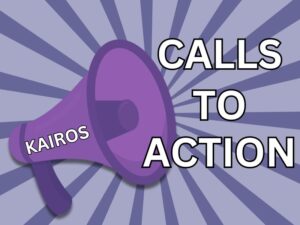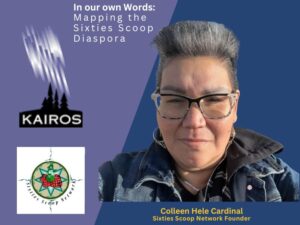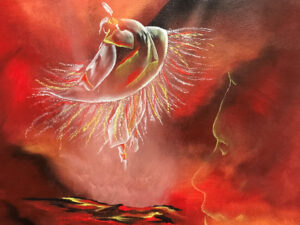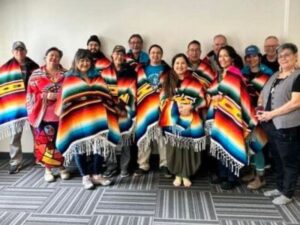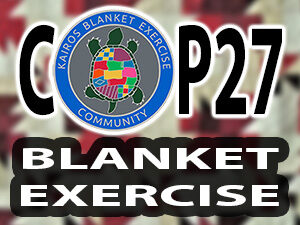The KAIROS Blanket Exercise in Ireland
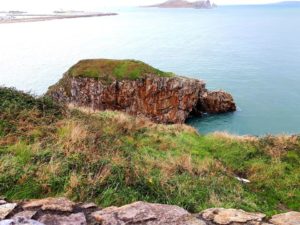
A KAIROS Blanket Exercise (KBE) team travelled to Ireland in November to facilitate the exercise for Trócaire, a development and emergency relief agency that works “to support the most vulnerable people in the developing world, while also raising awareness of injustice and global poverty in Ireland.”
Tealey Ka’senni:saks Normandin, who is Mohawk from Kahnawake and a 60’s scoop adoptee and knowledge carrier, and Alfredo Barahona – KAIROS Blanket Exercise Global and Newcomer Program Coordinator, co-facilitated with Su Tardif, a KBE facilitator from Montreal.
Nov. 16, 2018. It is 10:43 am in Dublin (5:43 am Toronto). As I await the boarding call for my return flight to Turtle Island, I review the memories of t he week in Ireland. We did so much that it feels as if we were here for much longer.
Tealey and Su are already on their way home. There were tears and laughter. There was tension but there was also relief. Tears came as we did the KBE and heard our Irish and Travellers[1] sisters and brothers tell us how similar the history in the KBE is to that of Ireland. Irish Travellers experience racism and discrimination and as result high levels of suicide. “It’s the same,” said Tealey, tears rolling down her face. We were at the Pavee Point Traveller and Roma Community Centre.
Jean Paul, one of the coordinators at the Community Centre, said the travellers are resisting and finding ways to organize and protect their rights. They are from this land. They have their own culture and way of life. They want that respected. Jean Paul says they have a similar exercise called the “Mats Game” where Irish and other people are asked to step into the shoes of the Travellers.
The Travellers work and share a building with Roma People who suffer discrimination, racism and marginalization in Ireland and all over Europe. Together they work to lead their common struggle and to provide services and support to their communities in Ireland. They run youth, women, health, and education programs. They explained how they’ve gone from “being led” to being leaders in advocating for and providing services to their people. This resonates with Tealey’s experience in Montreal. “It is like sitting in front of a mirror,” she said.
The offices of Trocáire, which hosted the KBE, are in a former seminary. At the entrance is an 800-year-old Yew tree that is sacred to the Irish people.
Reflecting on this experience and looking forward to other opportunities to share the KBE globally, I realize that it is much more than a workshop or interactive exercise.
It is the relationships we build and the friends we make when we facilitate the KBE. We learn how the history binds us together. And how we are connected. It is the history that has been hidden from us and that prevents us from knowing our ancestors, the legacy of their sacrifice, their wisdom and teachings, such as speak only words that are necessary, when necessary, and their unbreakable spirit and ancient wisdom.
It is the sight of an 800-hundred-year-old Yew tree and a Mohawk woman praying to the grandfather tree for a friend across the ocean on Turtle Island who is going through a difficult time.
Tealey asked about my responsibilities at KAIROS. I explained that my job involves working with partners outside of Canada to bring the KBE experience to their countries and to collaborate on the development of KBE scripts based on their specific history.
More than a very effective interactive workshop, the KBE is the relationships and friendships we build. It is all the people who help us. The KBE is the solidarity we offer and receive. It is the tears we cry and the pain we endure, the laughter we share and the goodbyes we say. It is one of the steps we take to resist with all our strength. And above all, it represents the Spirit that guides us. Colonialism may make us cry. Our bodies may ache and die. But our spirits live on and spread out with the KBE.
Now it is past 12:00 noon in Ireland (7:00 am Toronto). I am approximately 40,000 feet up in the air over the mighty Atlantic. As I finish writing this I remember what Lorena, a Xinca healer from Guatemala in Mesoamerica told me: “Your ancestors walk with you”. To my ancestors I say: “I feel you. I know who you were. I know who you are. I know who I am. I’ll go where you want me to go. I’ll take on the struggles you want me to take on. Because I know you walk with me.” Tears of gratitude flow cleansing my soul and spirit.
“Let the spirit guide us”, I often say. And here I am returning from Ireland with the feeling that the ancestors put in a good word for me with the Creator. I was in Guatemala in October working with the Maya Achi people of Rabinal in Baja Vera Paz on a KBE that reflects their history, and I heard the same words.
No doubt we will go to other places and hear the same words: Ancestral knowledge and Wisdom. Resistance and Resilience. Truth and Reconciliation. Love and Hope. Peace and Solidarity. I believe it is our time.
[1] Travellers are a distinct ethnic group with their own culture, shared history, language, traditions, perceptions and sense of belonging, a nomadic tradition and a distinct cultural identity. Irish Travellers are an important part of the existing cultural and ethnic diversity in Ireland. Irish Travellers have been documented as being part of Irish society for centuries. The distinctive Traveller identity and culture, based on a nomadic tradition, sets Travellers apart from the sedentary population or ‘settled people’.
https://www.paveepoint.ie/wp-content/uploads/2010/08/ChallengingMyths05.pdf




